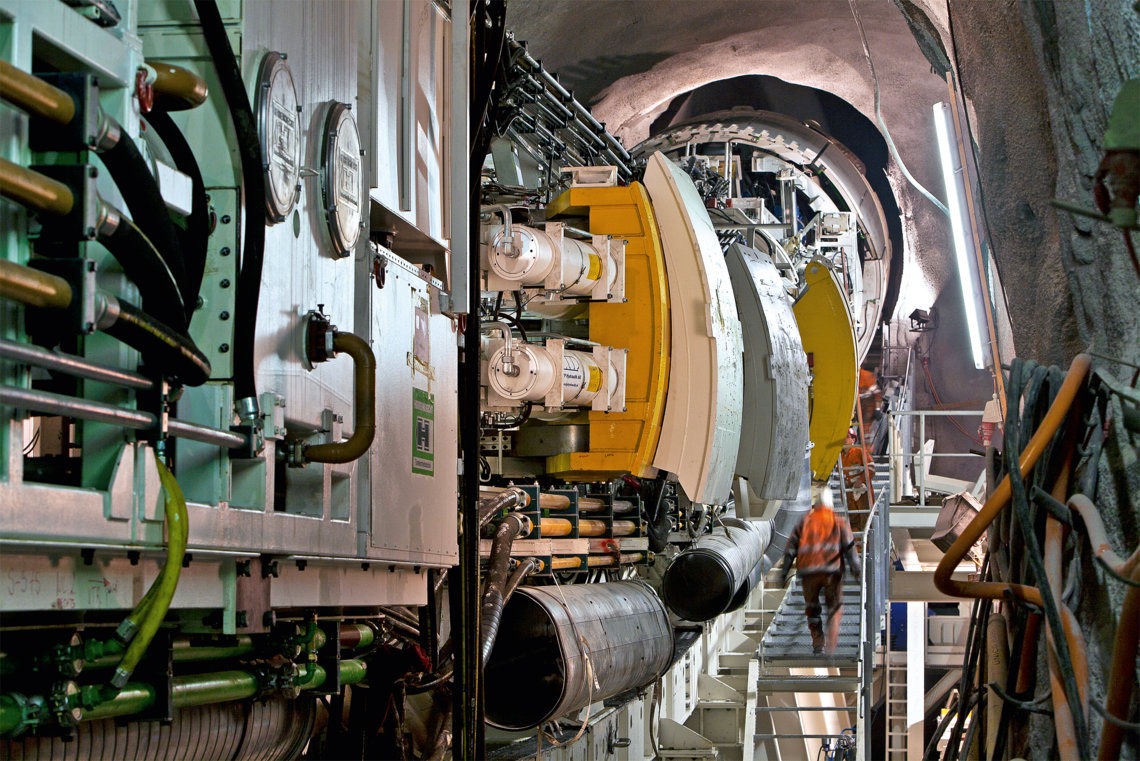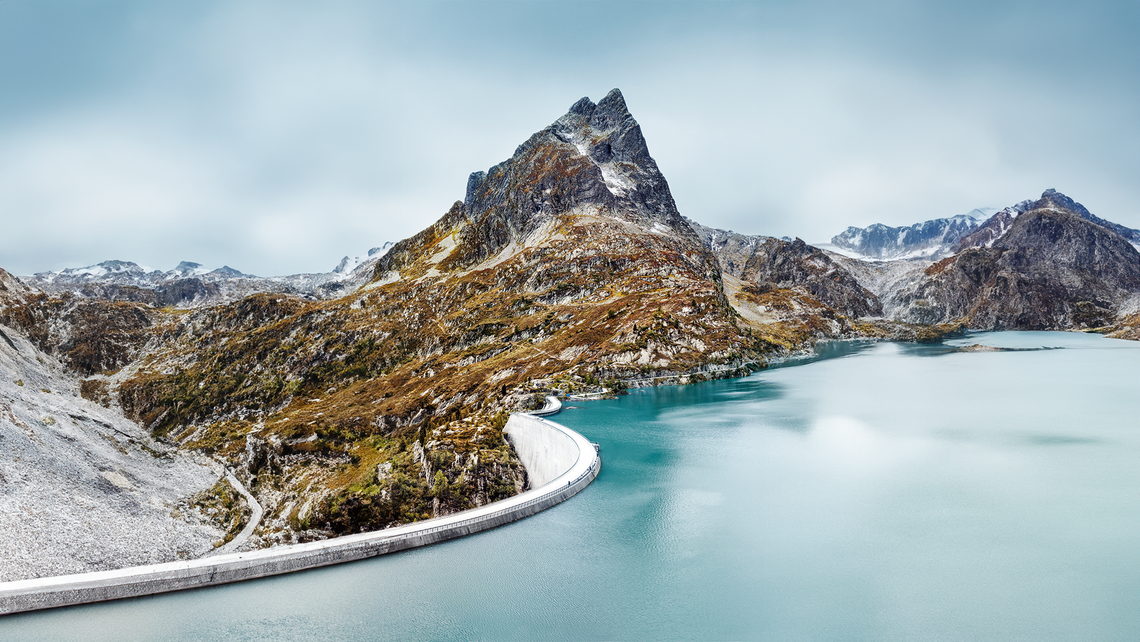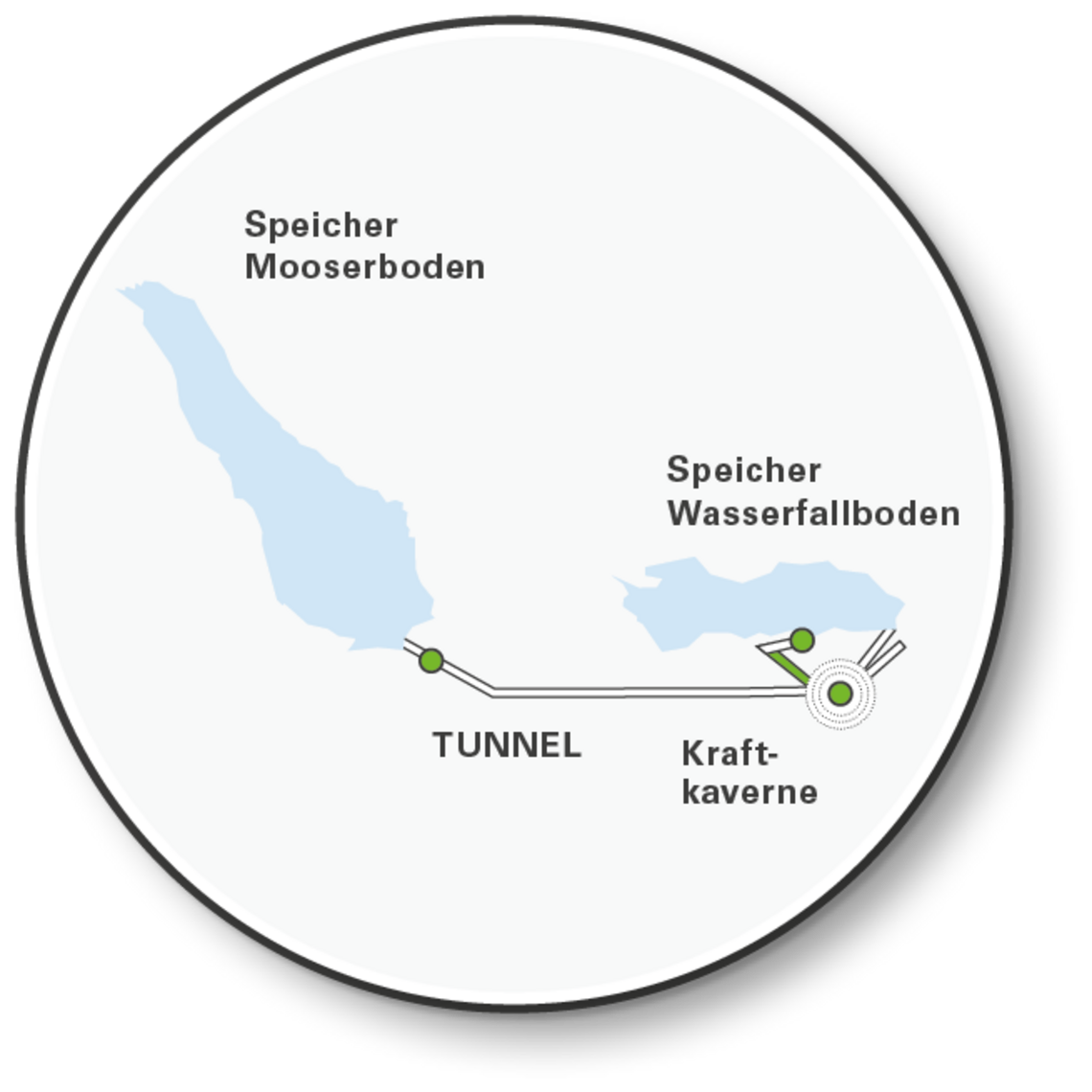Hydropower is a key to the successful global energy transition. Herrenknecht tunnelling technology from Schwanau is applied in the construction of pumped-storage power plants all over the world. Even ambitious hydropower plant projects are realized safely and quickly.
Reading time: 9 minutes
Even the experienced tunnellers on board the tunnel boring machine were feverishly awaiting this breakthrough: on October 3, 2022, at approximately 4 p.m. local time, after around three months of tunnelling, TBM S-1319 reached the target cavern of the “Limberg 3” project deep in the marl schist of the High Tauern mountain range south of Salzburg. When the cutterhead came to a halt and the first team member climbed through the manhole a short time later, cheers broke out among those present.
“At that moment, the tension of many months fell away from us,” says Herrenknecht project manager Steffen Wiedemer, who accompanied the entire drive on site. “This was a mission I really wanted to see up close.”
A special “climbing tour”
This mission was a “climbing tour” deep inside the mountain that even tunnellers don’t experience every day: for around three months, a 105 meter long Gripper machine with a diameter of 5.8 meters and a weight of almost 1,000 tonnes had constructed a 770 meter long inclined shaft with a gradient of 42 degrees.
To put that in perspective: the Bergisel ski jump in Innsbruck has a slope of only 35 degrees. 42 degrees can rather be compared to the angle between the long side and the legs of a set square. “Such a steep incline poses extreme challenges for the machine and therefore the whole team,” says Wiedemer.
Technology for steep climbs
The S-1319 Gripper TBM is different from other TBMs of this type. It is designed in such a way that it cannot, under any circumstances, slide back and down through the shaft it has constructed. For this reason, the machine has three bracing levels that press against the tunnel wall.
"Two of these grippers hold the TBM in place at every stage of the drive," Wiedemer explains. In addition, two of the three bracing levels are what are known as anti-slip units, which basically function like barbs. The slightest backward movement of the machine would cause it to mechanically wedge.
"This way, if the hydraulics should fail as a result of a complete blackout, the machine will automatically hold itself tightly in place in the tunnel," says Wiedemer. For added safety, each of the three bracing levels is strong enough to hold the TBM in the rock on its own. "Sliding down the shaft is thus absolutely reliably ruled out," says Steffen Wiedemer.
The diagonal drive in the rock poses further challenges that must already be taken into account in the design of such machines. For example, the disc cutters can be changed from the inside, so no one has to work in front of the tunnel face. In addition, the entire control cabin can always be brought into line, no matter how inclined the machine is.
Safety is also provided for by a closed spoil chute in which the excavated material slides downhill into the launch cavern. From there, the crew and material are transported to the machine in a kind of gondola. And something else is reminiscent of a climbing tour: "Everything that could fall down is secured with carabiners," says Steffen Wiedemer.
Wide range of technological challenges
For projects in rough terrain, the ground exploration program is particularly complex and an additional challenge. "For tunnels, exploratory drilling is done during the planning phase," says Dr.-Ing. Karin Bäppler, Head of Business Development, Business Unit Traffic Tunnelling, at Herrenknecht AG. With any tunnel project there is a risk of encountering unforeseen ground conditions. However, past projects have shown that these risks can be managed, she says.
If, for example, the machine drives through fault zones, for example, areas characterized by structural changes in a rock formation, the further path of the TBM can be stabilized by injecting a special material into the rock. "With the help of such injections, problematic geology can usually be stabilized to the point where safe tunnelling is possible," says Karin Bäppler.
“Such a steep incline of a 42-degree slope poses extreme challenges for the machine and therefore the whole team.”
Steffen Wiedemer, Project Manager, Herrenknecht AG

A twin anti-slip system with full redundancy of the gripper levels reliably prevents the Gripper TBM for Limberg from slipping back.
Herrenknecht pioneers for extreme climbs
With the development of the TBM for "Limberg 3", Herrenknecht once again did pioneering work in mechanized tunnelling. The engineers in Schwanau were able to draw on experience from previous hydropower projects with extreme gradients.
Back in 2010, a Herrenknecht TBM with a diameter of 5.12 meters built a headrace tunnel with a gradient of around 41 degrees for the "Limmern" project in the Swiss canton of Glarus. In 2021, construction began on a headrace tunnel with a gradient of almost 42 degrees for the "Ritom" project in the Swiss canton of Ticino. And since the summer of 2023, a TBM with a diameter of 11 meters has been constructing an inclined shaft with a gradient of 25 degrees, a record for this diameter, for the "Snowy 2.0" project in southern Australia.
A mainstay of the energy transition
"We notice that projects are becoming more ambitious," says Bäppler, who advises customers in the early stages of planning and design. The reason for the growing demand for hydropower plants is obvious: the expansion of renewable energy sources is urgently needed if the global climate crisis is to at least be mitigated. At the UN Climate Change Conference in Paris in 2015, 197 countries around the world set themselves the goal of limiting global warming to well below 2 degrees Celsius. 191 countries have now ratified the Paris Agreement.
Even if the political course is set to accelerate the global energy transition: efforts to expand hydropower as an energy source were already being made in numerous countries around the world before the Paris Agreement. And it's not always about steep shafts with large diameters. The Val d'Astico project in the northern Italian province of Vicenza shows it can be done a few sizes smaller. This is a small hydropower plant where a Herrenknecht HDD Trailer Rig was used. Drilling almost a kilometer, the machine installed an 8-inch stainless steel pipeline, overcoming an elevation difference of 450 meters.
Ambitious hydropower projects worldwide
In other projects, larger machines are used, but smaller gradients have to be mastered. From 2009 to 2011, a Double Shield TBM with a diameter of 4.62 meters excavated a 12.4 kilometer long inlet tunnel for the 80 megawatt Palomino hydropower station in the Dominican Republic, which went online in 2012.
An even bigger project was started in Ecuador in 2012. Here, two identical Double Shield TBMs with a diameter of 9.11 meters created an almost 25 kilometer long inlet tunnel for the "Coca Codo Sinclair" waterworks with an output of 1,500 megawatts. It went into operation in 2016 and produces around 30 percent of the country's electricity needs. The plant plays a key role in Ecuador's plans to increase the share of hydropower in the country's energy budget to around 90 percent.
The member states of the European Union also set themselves an ambitious target. They want to make the EU the first climate-neutral society by 2050. Austria, the country where the "Limberg 3" power plant is currently being built, is even going a step further and is aiming for climate neutrality by 2040. Up to 67 percent of the electricity produced in the Alpine country already comes from hydropower plants. In the Kaprun Valley too, water flowing downwards has been converted into electricity for nearly seventy years; but the share of renewables must continue to rise, and more hydropower plants must be built.
“We notice that projects are becoming more ambitious, because renewable energy sources urgently need to be expanded if the global climate crisis is to at least be mitigated.”
Dr. Dipl.-Ing. Karin Bäppler,
Head of Business Development, Business Unit
Traffic Tunnelling, Herrenknecht AG

With a capacity of 900 MW, Nant de Drance is one of the most powerful pumped storage power plants in Europe. It plays an important role in stabilizing the European power grid and ensuring security of supply in Switzerland.
Limberg III: power plant and green power bank
In 2025, when "Limberg 3" goes into operation, water from a reservoir in the Kaprun Valley will be fed through a tunnel to the steep pressure shaft built by the Herrenknecht TBM. It will plunge down through this shaft into the so-called power cavern – the size of the inner nave of Vienna's St. Stephen's Cathedral – and drive two 240-megawatt turbines. The water will then flow into another reservoir and further down into the valley.
The charm of such a pumped storage power plant: it also works in the opposite direction. If, for example, more electricity is available from photovoltaics or wind power than is needed, the powerful turbines can pump the water back up into the higher reservoir. It becomes a gigantic green power bank. As part of the Kaprun power plant group, "Limberg 3" will make a significant contribution to grid stability in Austria.
If you want to experience the blue power from which green electricity is generated here, you can climb the dizzying via ferrata fixed rope route at one of the dams. Along cleverly laid steps, handholds and ropes, the route here climbs an incredible 107 meters steeply uphill. Once on the crest of the dam wall, you'll see lush green slopes, turquoise blue reservoirs and snow-capped mountain ranges. The future of energy supply is sensational in many regards.


Mathias Becker
is head of copy at corporate publishing agency Behnken, Becker + Partner.
As an author, Becker focuses on how technical innovations promote social progress. For Herrenknecht he has already reported on the Eurasia Tunnel in Istanbul and the railway project High Speed 2 in England.

Header image: © Marti AG